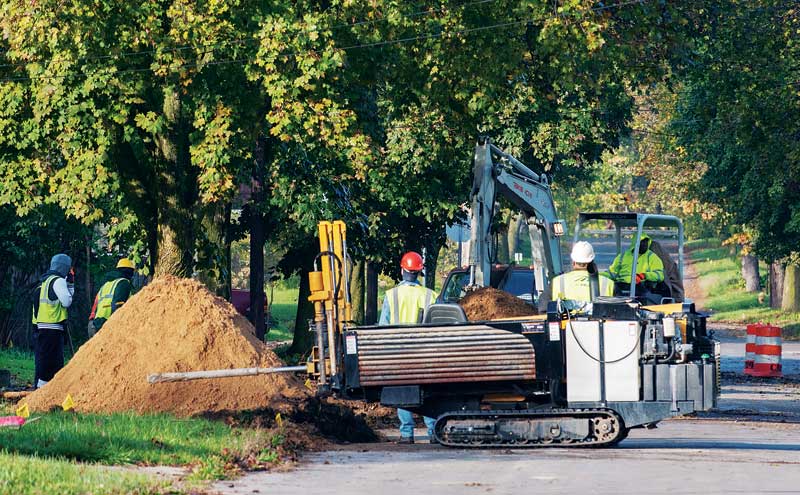
Proven safety and reliability
Copper has been used to deliver safe drinking water to civilizations for thousands of years. It was employed as a conduit material to distribute water at Abusir by the ancient Egyptians around 2150 BC, and it was widely used for water pipes and cisterns by the ancient Romans. Its extensive use has allowed for better understanding of its properties as well as its potential health and safety effects. Researchers know why leaching occurs and how it can be controlled.
While not common in most U.S. waters, copper can leach out of pipes. Some waters have low pH or very high alkalinity, in which cases copper leaching can exceed the federal mandated level. In the United States, only two to five percent of waters exhibit this natural trait, so it is not a major occurrence; more importantly, it can be predicted.
The U.S. Environmental Protection Agency (EPA) established the Lead and Copper Rule to regulate the amount of these metals in drinking water. Lead is regulated at 15 parts per billion (ppb) in water, which is 87 times more restrictive than the 1300 ppb allowable for copper. While lead is a quite serious neurotoxin that has severe adverse health effects associated with even very low intake concentrations, copper is necessary for human life and development. The copper level was set to protect against chronic effects (e.g. liver and kidney damage) occurring after prolonged exposure at high levels. This is particularly true for those with the genetic condition Wilson’s Disease, which affects an estimated one in 30,000 people in the country. These sensitive individuals cannot automatically regulate the levels of copper in the body, which can lead to a long-term buildup of copper and increase the likelihood of these chronic effects.
According to the EPA, no amount of lead ingestion as indicated by blood lead levels is safe for children, as it can cause developmental delays, irreversible cognitive and behavioral problems, anemia, seizures, coma, and other adverse health issues. However, regular ingestion of copper is essential for the development of bone, red blood cells, connective tissues, brain, heart, and other organs; it is also necessary in the absorption of other minerals and in the metabolizing of cholesterol and glucose.
Most knowledge on the health, safety, and reliability of piping materials comes from long-term use and service—a history plastics do not have. One of the reasons for this is when problems develop with the use of one type of polymer-based material, the industry switches to a different type of plastic. While this solves one problem, it also begins the learning curve for the next problem all over again—‘new’ often equals ‘unknown.’
However, recent studies by AWAA and others indicate plastic materials (e.g. polyvinyl chloride [PVC], chlorinated polyvinyl chloride [CPVC], polyethylene [PE], polybutylene [PB], and acrylonitrile-butadiene-styrene [ABS]) can leach chemicals that affect taste and odor, but are difficult to identify. They also demonstrate certain products can be inconsistent between type of plastic and manufacturer and, most importantly, have little to no information on how these materials might affect human health.
| COPPER TUBE 101 |
| Copper tube for plumbing applications is extruded from a solid copper billet or tube shell into a long, seamless tube made from 99.9 percent pure copper. Seamless copper tube is furnished according to several ASTM specifications in six standard types. Copper water tube (ASTM B88, Standard Specification for Seamless Copper Water Tube) is the most widely used; it includes Types K, L, and M tube (see table below). It is designated by nominal sizes, with the outside diameter being 3.2 mm (1/8 in.) larger than the nominal size. The only difference among the three types is their wall thickness, with Type K having the thickest wall and Type M the thinnest. These different tube sizes allow the system designer to optimize the design by selecting the type most closely matching the necessary pressure rating of the system. (For underground water services, Type K is recommended and most commonly used.)
Two other nominally sized copper tube types are available for specific applications. Copper drainage tube, Type DWV (ASTM B306, Standard Specification for Copper Drainage Tube) is available in hard temper for sanitary drainage, waste, and vent (DWV) applications. Medical gas tube (ASTM B819, Standard Specification for Seamless Copper Tube for Medical Gas Systems), also nominally sized, is available in hard temper, straight lengths only. It is furnished in Types K or L for different pressure applications. To maintain the utmost cleanliness of the medical gas distribution system until it is installed, the interior of this type of tube is specially cleaned and is supplied capped. Unlike the tube types previously mentioned, copper tube for air-conditioning and refrigeration field service (ACR) is not nominally sized. Like most of the components in the refrigeration and heat-transfer field, ACR tube (ASTM B280, Standard Specification for Seamless Copper Tube for Air-conditioning and Refrigeration Field Service) is designated by its actual outside diameter. As with medical gas tube, it is supplied cleaned and capped. |





